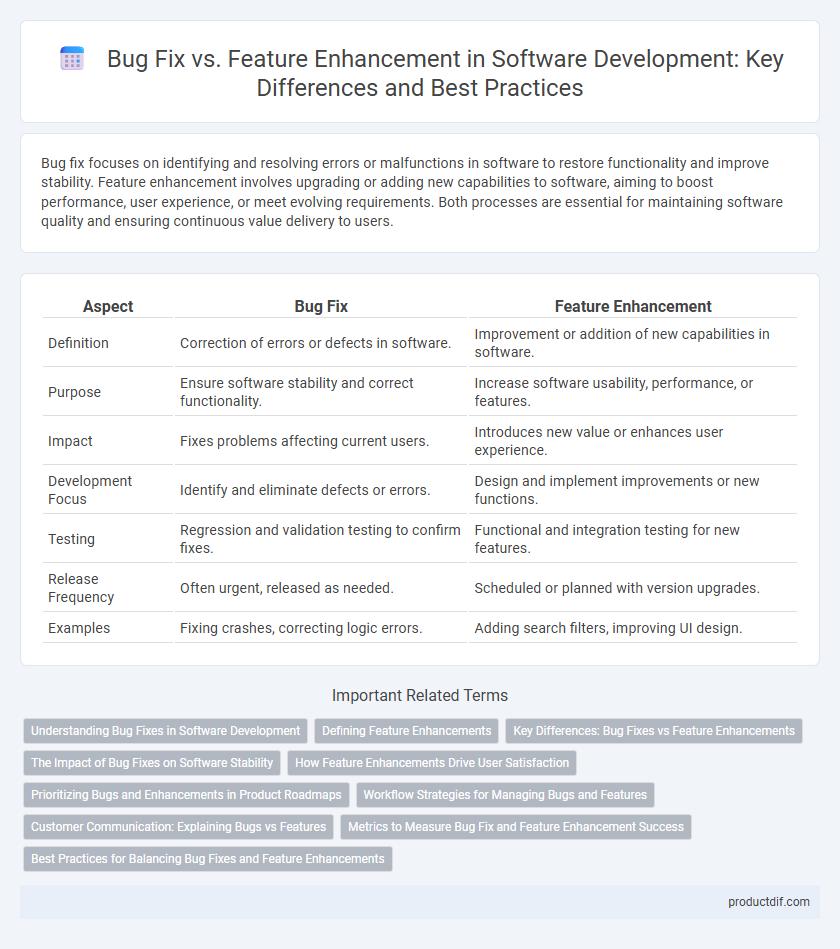Bug fix focuses on identifying and resolving errors or malfunctions in software to restore functionality and improve stability. Feature enhancement involves upgrading or adding new capabilities to software, aiming to boost performance, user experience, or meet evolving requirements. Both processes are essential for maintaining software quality and ensuring continuous value delivery to users.
Table of Comparison
| Aspect | Bug Fix | Feature Enhancement |
|---|---|---|
| Definition | Correction of errors or defects in software. | Improvement or addition of new capabilities in software. |
| Purpose | Ensure software stability and correct functionality. | Increase software usability, performance, or features. |
| Impact | Fixes problems affecting current users. | Introduces new value or enhances user experience. |
| Development Focus | Identify and eliminate defects or errors. | Design and implement improvements or new functions. |
| Testing | Regression and validation testing to confirm fixes. | Functional and integration testing for new features. |
| Release Frequency | Often urgent, released as needed. | Scheduled or planned with version upgrades. |
| Examples | Fixing crashes, correcting logic errors. | Adding search filters, improving UI design. |
Understanding Bug Fixes in Software Development
Bug fixes in software development address defects or errors that disrupt functionality, ensuring system stability and reliability. Identifying root causes through debugging and testing allows developers to correct issues without altering existing features. Timely bug resolution minimizes user impact and maintains software quality throughout the development lifecycle.
Defining Feature Enhancements
Feature enhancements in software development involve improving existing functionalities to increase user satisfaction, performance, or usability without altering the core purpose of the application. These updates often introduce new user interface elements, optimize workflows, or expand capabilities based on user feedback and market demands. Unlike bug fixes, feature enhancements aim to add value by refining and extending software features.
Key Differences: Bug Fixes vs Feature Enhancements
Bug fixes address defects in software to improve stability, security, and functionality by correcting errors that cause unintended behavior or crashes. Feature enhancements involve adding new capabilities or improving existing functionalities to increase user satisfaction and adapt to evolving requirements. Key differences include their objectives--bug fixes restore proper operation, while feature enhancements drive innovation and expand software capabilities.
The Impact of Bug Fixes on Software Stability
Bug fixes directly enhance software stability by resolving errors that cause crashes, data corruption, or security vulnerabilities, ensuring smoother performance and reliability. Timely identification and correction of bugs reduce downtime and improve user satisfaction by preventing recurring issues and system failures. Consistent bug fixing also maintains code integrity, supporting long-term software maintainability and scalability.
How Feature Enhancements Drive User Satisfaction
Feature enhancements directly improve software functionality, making applications more intuitive and aligned with user needs. By continuously integrating new capabilities, development teams increase user engagement and retention, resulting in higher satisfaction. Prioritizing enhancements based on user feedback ensures the software evolves with market demands and competitive standards.
Prioritizing Bugs and Enhancements in Product Roadmaps
Prioritizing bugs and feature enhancements in product roadmaps requires balancing user impact with development resources, ensuring critical bugs that affect functionality or security are addressed before implementing new features. Data-driven methods like customer feedback analysis, bug severity scores, and usage metrics optimize decision-making for improving product stability and user satisfaction. Incorporating agile methodologies allows continuous reassessment of priorities, enabling dynamic shifts between fixing defects and enhancing capabilities based on evolving market demands.
Workflow Strategies for Managing Bugs and Features
Effective workflow strategies for managing bugs and feature enhancements involve distinct prioritization and tracking mechanisms within software development. Bug fixes require immediate attention using bug tracking systems such as Jira or Bugzilla to ensure timely resolution and maintain software stability. Feature enhancements follow a structured product backlog process with tools like Trello or Asana, allowing prioritization based on user feedback and roadmap alignment.
Customer Communication: Explaining Bugs vs Features
Clearly distinguishing between bug fixes and feature enhancements in customer communication ensures transparency and sets realistic expectations. Bug explanations should detail the issue's impact on functionality and outline corrective actions, while feature enhancement discussions emphasize added value and usability improvements. Effective communication reduces confusion and increases customer satisfaction by aligning technical solutions with user needs.
Metrics to Measure Bug Fix and Feature Enhancement Success
Measuring bug fix success relies heavily on metrics such as Mean Time to Resolve (MTTR), the rate of reopened bugs, and user-reported issue volume to assess stability improvements. Feature enhancement success is often quantified through adoption rates, user engagement metrics like daily active users (DAU), and satisfaction scores obtained from customer feedback. Tracking these metrics provides actionable insights to optimize development priorities and improve software quality over time.
Best Practices for Balancing Bug Fixes and Feature Enhancements
Prioritizing bug fixes based on severity and user impact ensures system stability while allocating resources to feature enhancements drives product innovation. Employing agile methodologies facilitates iterative releases that balance immediate bug resolutions with incremental feature improvements. Continuous integration and automated testing reduce regression risks, enabling simultaneous progress on critical fixes and new functionalities without compromising quality.
Bug Fix vs Feature Enhancement Infographic

 productdif.com
productdif.com